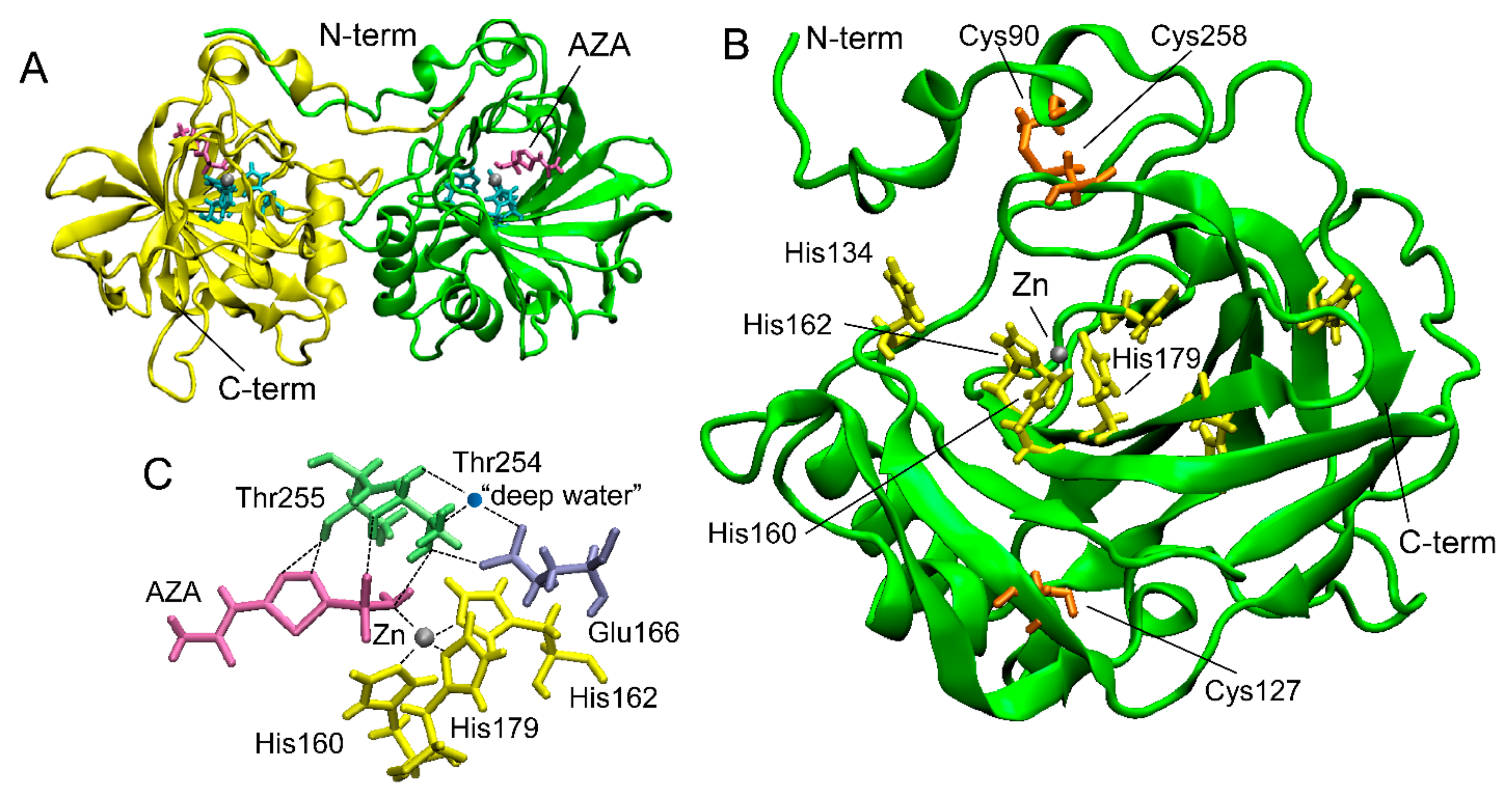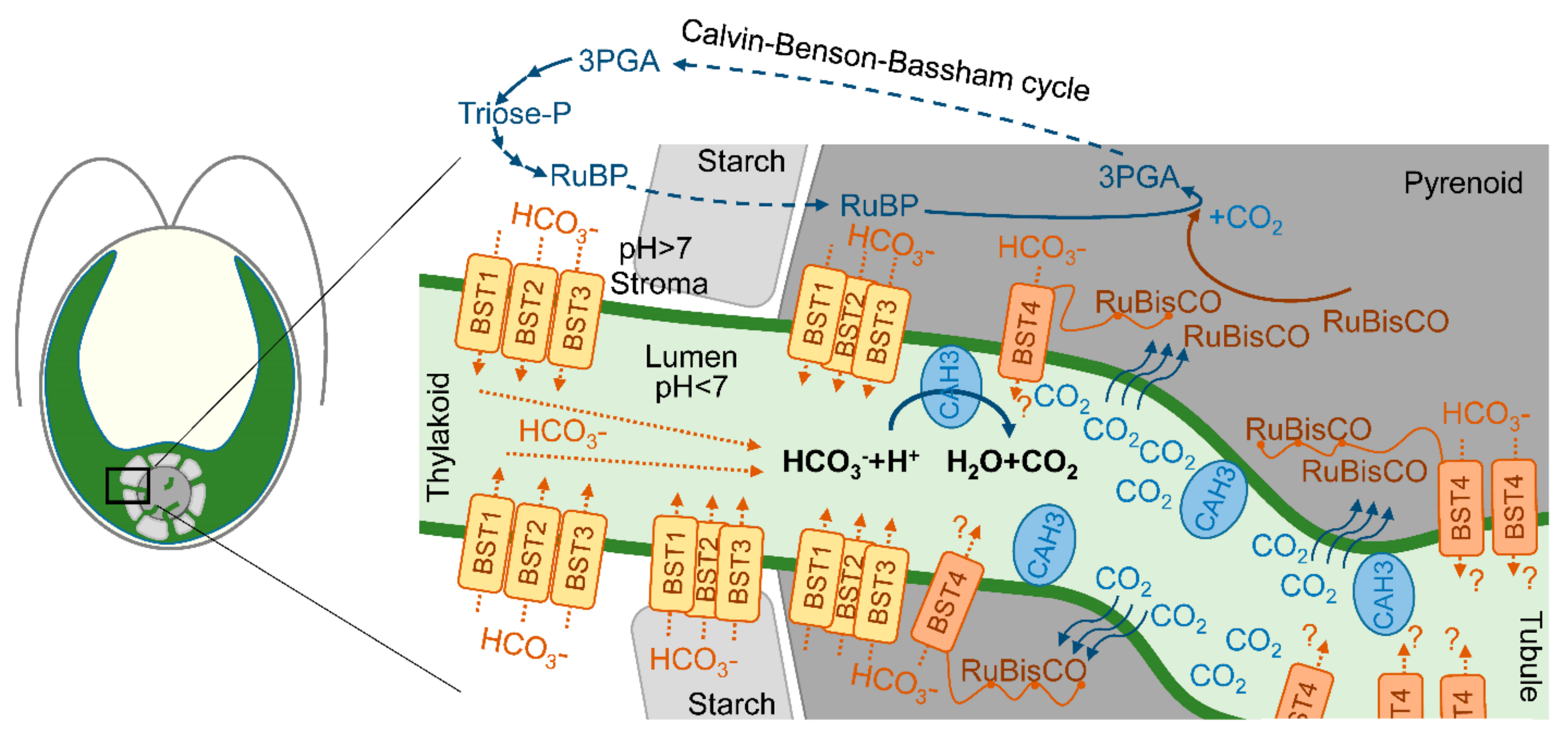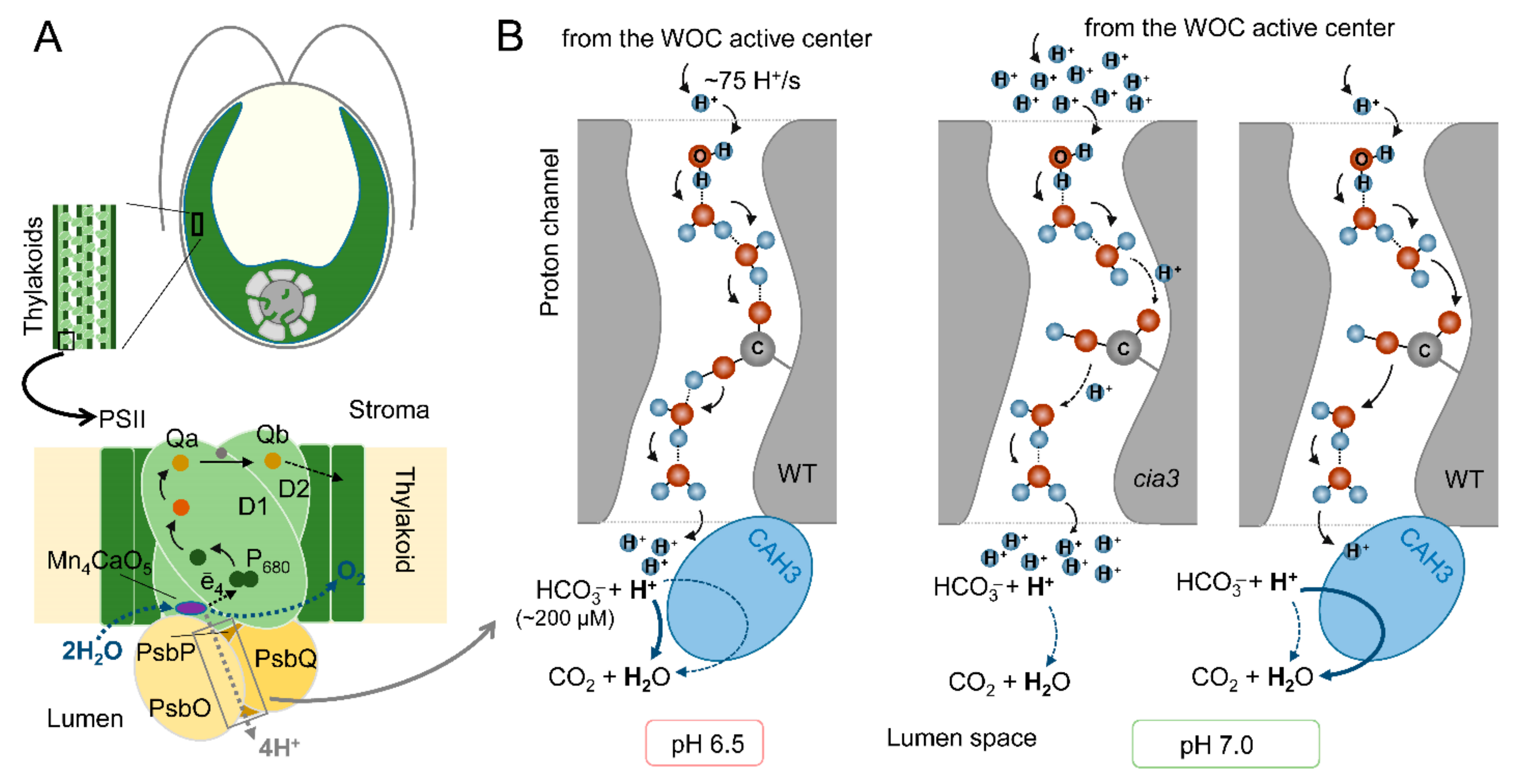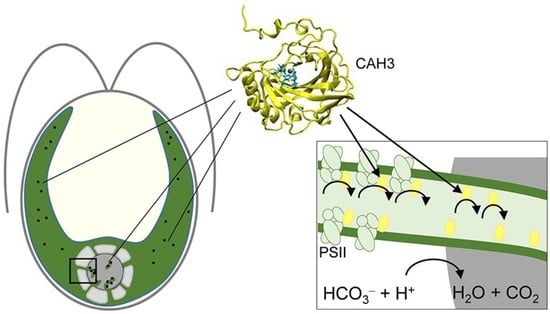CAH3 from Chlamydomonas reinhardtii: Unique Carbonic Anhydrase of the Thylakoid Lumen
Abstract
1. Introduction
2. Chloroplast-Located CA Activity
3. Amino Acid Sequence of the CAH3 Protein and Immuno-Analysis
4. Production of the Recombinant Protein and Its Crystal Structure
| Protein | WAU | IC50 | DTT/β-ME | Ref. |
|---|---|---|---|---|
| rCAH3 (α) | 750 (1600) | AZA, 8 × 10−9 EZA, 6 × 10−9 Azide, 3.2 × 10−5 Cyanide, 5.9 × 10−5 | ↓ | [25] (Shutova et al., 2008, unpublished data) |
| rCAH6 (β) | 940 | EZA, 2 × 10−6 Azide, 1.5 × 10−5 Cyanide, 5 × 10−5 | no | [25] |
| rCAH7 (β) | 3.1 | AZA, 4.4 × 10−5 EZA, 4.4 × 10−4 Azide, 3.2 × 10−5 Cyanide, 6.1 × 10−4 | ↑ | [16] |
| rCAH8 (β) | 4.2 | AZA, 1.7 × 10−7 EZA, 4.1 × 10−4 Azide, 1.9 × 10−3 Cyanide, 1.5 × 10−5 | no | [16] |
| rLCIC, rLCIB, rLCIC-LCIB (β) | no | – | – | [13] |
| nCAH3 (α) | 2040 | AZA, 12 × 10−9 | – | [20] |
| nCAH1 (α) | 2580 | AZA, 3 × 10−9 EZA, 2 × 10−9 | ↓ | [29,47,49] |
| nCAH2 (α) | 3300 | AZA, 3 × 10−9 EZA, 2 × 10−9 | ↓ | [29] |
| r-Bovine CAII (α) | 9333 | AZA, 1.4 × 10−8 EZA, 1.2 × 10−9 Azide, 1.1 × 10−3 Cyanide, 4.9 × 10−5 | no | [40,50] |
5. Involvement CAH3 in CCM
| Strains | Initial External Ci, μM | Internal Ci, mM | Ref. |
|---|---|---|---|
| WT 2137 | 80 | ~1.0 | |
| +50 µM EZA | 80 | ~10.0 | [34,35] |
| ca-1-12-1C | 80 | ~13.2 | |
| Strain 90 | 20 | ~0.25 * | |
| +50 µM EZA | 20 | ~1.10 * | [60] |
| +50 µM AZA | 20 | ~0.25 * | |
| WT CC-125 | 50 | 1.80 ± 0.33 | |
| ad1 (LCIB–def.) | 50 | 0.26 ± 0.08 | [55] |
| WT-su6 | 50 | 7.60 ± 1.25 | |
| ad1-su6 | 50 | 6.15 ± 1.15 | |
| cia5 | 50 | 0.19 ± 0.05 | |
| WT CC-125 | 50 | ~1.25 | |
| ad1 (LCIB–def.) | 50 | ~0.20 | [61] |
| WT D66 | 50 | ~0.95 | |
| bsti-1 (BST1–def.) | 50 | ~0.33 | [53] |
| bsti-2 (BST2–def.) | 50 | ~0.50 | |
| bsti-3 (BST3–def.) | 50 | ~0.51 | |
| WT D66 | 25 | ~0.38 | |
| cah4/5-1 (CAH4/5–def.) | 25 | ~0.10 | [54] |
| cah4/5-2 (CAH4/5–def.) | 25 | ~0.20 |
6. Functional and Structural Interconnection between CAH3 and PSII
7. Incorporation of CAH3 into Higher Plants
Author Contributions
Funding
Institutional Review Board Statement
Informed Consent Statement
Data Availability Statement
Conflicts of Interest
References
- Wang, X.; Conway, W.; Burns, R.; McCann, N.; Maeder, M. Comprehensive Study of the Hydration and Dehydration Reactions of Carbon Dioxide in Aqueous Solution. J. Phys. Chem. A 2010, 114, 1734–1740. [Google Scholar] [CrossRef] [PubMed]
- Soli, A.L.; Byrne, R.H. CO2 System Hydration and Dehydration Kinetics and the Equilibrium CO2/H2CO3 Ratio in Aqueous NaCl Solution. Mar. Chem. 2002, 78, 65–73. [Google Scholar] [CrossRef]
- Johnson, K.S. Carbon Dioxide Hydration and Dehydration Kinetics in Seawater1. Limnol. Oceanogr. 1982, 27, 849–855. [Google Scholar] [CrossRef]
- Hilvo, M.; Baranauskiene, L.; Salzano, A.M.; Scaloni, A.; Matulis, D.; Innocenti, A.; Scozzafava, A.; Monti, S.M.; Di Fiore, A.; De Simone, G.; et al. Biochemical Characterization of CA IX, One of the Most Active Carbonic Anhydrase Isozymes. J. Biol. Chem. 2008, 283, 27799–27809. [Google Scholar] [CrossRef] [PubMed]
- Rudenko, N.N.; Ignatova, L.K.; Nadeeva-Zhurikova, E.M.; Fedorchuk, T.P.; Ivanov, B.N.; Borisova-Mubarakshina, M.M. Advances in Understanding the Physiological Role and Locations of Carbonic Anhydrases in C3 Plant Cells. Protoplasma 2021, 258, 249–262. [Google Scholar] [CrossRef]
- Aspatwar, A.; Haapanen, S.; Parkkila, S. An Update on the Metabolic Roles of Carbonic Anhydrases in the Model Alga Chlamydomonas reinhardtii. Metabolites 2018, 8, 22. [Google Scholar] [CrossRef]
- Wang, Y.; Stessman, D.J.; Spalding, M.H. The CO2 Concentrating Mechanism and Photosynthetic Carbon Assimilation in Limiting CO2: How Chlamydomonas Works against the Gradient. Plant J. 2015, 82, 429–448. [Google Scholar] [CrossRef]
- DiMario, R.J.; Machingura, M.C.; Waldrop, G.L.; Moroney, J.V. The Many Types of Carbonic Anhydrases in Photosynthetic Organisms. Plant Sci. 2018, 268, 11–17. [Google Scholar] [CrossRef]
- Klimov, V.; Baranov, S. Bicarbonate Requirement for the Water-Oxidizing Complex of Photosystem II. Biochim. Biophys. Acta—Bioenerg. 2001, 1503, 187–196. [Google Scholar] [CrossRef]
- Terentyev, V.V.; Shukshina, A.K.; Shitov, A.V. Carbonic Anhydrase CAH3 Supports the Activity of Photosystem II under Increased PH. Biochim. Biophys. Acta—Bioenerg. 2019, 1860, 582–590. [Google Scholar] [CrossRef]
- Rudenko, N.N.; Fedorchuk, T.P.; Terentyev, V.V.; Dymova, O.V.; Naydov, I.A.; Golovko, T.K.; Borisova-Mubarakshina, M.M.; Ivanov, B.N. The Role of Carbonic Anhydrase α-CA4 in the Adaptive Reactions of Photosynthetic Apparatus: The Study with α-CA4 Knockout Plants. Protoplasma 2020, 257, 489–499. [Google Scholar] [CrossRef] [PubMed]
- Moroney, J.V.; Ma, Y.; Frey, W.D.; Fusilier, K.A.; Pham, T.T.; Simms, T.A.; DiMario, R.J.; Yang, J.; Mukherjee, B. The Carbonic Anhydrase Isoforms of Chlamydomonas reinhardtii: Intracellular Location, Expression, and Physiological Roles. Photosynth. Res. 2011, 109, 133–149. [Google Scholar] [CrossRef] [PubMed]
- Jin, S.; Sun, J.; Wunder, T.; Tang, D.; Cousins, A.B.; Sze, S.K.; Mueller-Cajar, O.; Gao, Y.-G. Structural Insights into the LCIB Protein Family Reveals a New Group of β-Carbonic Anhydrases. Proc. Natl. Acad. Sci. USA 2016, 113, 14716–14721. [Google Scholar] [CrossRef] [PubMed]
- Jungnick, N.; Ma, Y.; Mukherjee, B.; Cronan, J.C.; Speed, D.J.; Laborde, S.M.; Longstreth, D.J.; Moroney, J.V. The Carbon Concentrating Mechanism in Chlamydomonas reinhardtii: Finding the Missing Pieces. Photosynth. Res. 2014, 121, 159–173. [Google Scholar] [CrossRef] [PubMed]
- Jensen, E.L.; Maberly, S.C.; Gontero, B. Insights on the Functions and Ecophysiological Relevance of the Diverse Carbonic Anhydrases in Microalgae. Int. J. Mol. Sci. 2020, 21, 2922. [Google Scholar] [CrossRef] [PubMed]
- Ynalvez, R.A.; Xiao, Y.; Ward, A.S.; Cunnusamy, K.; Moroney, J.V. Identification and Characterization of Two Closely Related Β-carbonic Anhydrases from Chlamydomonas reinhardtii. Physiol. Plant. 2008, 133, 15–26. [Google Scholar] [CrossRef] [PubMed]
- Yamano, T.; Miura, K.; Fukuzawa, H. Expression Analysis of Genes Associated with the Induction of the Carbon-Concentrating Mechanism in Chlamydomonas reinhardtii. Plant Physiol. 2008, 147, 340–354. [Google Scholar] [CrossRef] [PubMed]
- Cardol, P.; Gonzaález-Halphen, D.; Reyes-Prieto, A.; Baurain, D.; Matagne, R.F.; Remacle, C. The Mitochondrial Oxidative Phosphorylation Proteome of Chlamydomonas reinhardtii Deduced from the Genome Sequencing Project. Plant Physiol. 2005, 137, 447–459. [Google Scholar] [CrossRef]
- Mackinder, L.C.M.; Chen, C.; Leib, R.D.; Patena, W.; Blum, S.R.; Rodman, M.; Ramundo, S.; Adams, C.M.; Jonikas, M.C. A Spatial Interactome Reveals the Protein Organization of the Algal CO2-Concentrating Mechanism. Cell 2017, 171, 133–147.e14. [Google Scholar] [CrossRef]
- Karlsson, J.; Ciarke, A.K.; Chen, Z.Y.; Hugghins, S.Y.; Park, Y.I.; Husic, H.D.; Moroney, J.V.; Samuelsson, G. A Novel α-Type Carbonic Anhydrase Associated with the Thylakoid Membrane in Chlamydomonas reinhardtii Is Required for Growth at Ambient CO2. EMBO J. 1998, 17, 1208–1216. [Google Scholar] [CrossRef]
- Karlsson, J.; Hiltonen, T.; Husic, H.D.; Ramazanov, Z.; Samuelsson, G. Intracellular Carbonic Anhydrase of Chlamydomonas reinhardtii. Plant Physiol. 1995, 109, 533–539. [Google Scholar] [CrossRef] [PubMed]
- Park, Y.I.; Karlsson, J.; Rojdestvenski, I.; Pronina, N.; Klimov, V.; Öquist, G.; Samuelsson, G. Role of a Novel Photosystem II-Associated Carbonic Anhydrase in Photosynthetic Carbon Assimilation in Chlamydomonas reinhardtii. FEBS Lett. 1999, 444, 102–105. [Google Scholar] [CrossRef] [PubMed]
- Villarejo, A.; Shutova, T.; Moskvin, O.; Forssén, M.; Klimov, V.V.; Samuelsson, G. A Photosystem II-Associated Carbonic Anhydrase Regulates the Efficiency of Photosynthetic Oxygen Evolution. EMBO J. 2002, 21, 1930–1938. [Google Scholar] [CrossRef] [PubMed]
- Markelova, A.G.; Sinetova, M.P.; Kupriyanova, E.V.; Pronina, N.A. Distribution and Functional Role of Carbonic Anhydrase Cah3 Associated with Thylakoid Membranes in the Chloroplast and Pyrenoid of Chlamydomonas reinhardtii. Russ. J. Plant Physiol. 2009, 56, 761–768. [Google Scholar] [CrossRef]
- Shutova, T.; Kenneweg, H.; Buchta, J.; Nikitina, J.; Terentyev, V.; Chernyshov, S.; Andersson, B.; Allakhverdiev, S.I.; Klimov, V.V.; Dau, H.; et al. The Photosystem II-Associated Cah3 in Chlamydomonas Enhances the O2 Evolution Rate by Proton Removal. EMBO J. 2008, 27, 782–791. [Google Scholar] [CrossRef]
- Terentyev, V.V.; Shukshina, A.K.; Ashikhmin, A.A.; Tikhonov, K.G.; Shitov, A.V. The Main Structural and Functional Characteristics of Photosystem-II-Enriched Membranes Isolated from Wild Type and Cia3 Mutant Chlamydomonas reinhardtii. Life 2020, 10, 63. [Google Scholar] [CrossRef] [PubMed]
- Shukshina, A.K.; Terentyev, V.V. Involvement of Carbonic Anhydrase CAH3 in the Structural and Functional Stabilization of the Water-Oxidizing Complex of Photosystem II from Chlamydomonas reinhardtii. Biochemistry 2021, 86, 867–877. [Google Scholar] [CrossRef]
- Rawat, M.; Moroney, J.V. Partial Characterization of a New Isoenzyme of Carbonic Anhydrase Isolated from Chlamydomonas reinhardtii. J. Biol. Chem. 1991, 266, 9719–9723. [Google Scholar] [CrossRef]
- Tachiki, A.; Fukuzawa, H.; Miyachi, S. Characterization of Carbonic Anhydrase Isozyme CA2, Which Is the CAH2 Gene Product, in Chlamydomonas reinhardtii. Biosci. Biotechnol. Biochem. 1992, 56, 794–798. [Google Scholar] [CrossRef]
- Sültemeyer, D.F.; Fock, H.P.; Canvin, D.T. Mass Spectrometric Measurement of Intracellular Carbonic Anhydrase Activity in High and Low Ci Cells of Chlamydomonas. Plant Physiol. 1990, 94, 1250–1257. [Google Scholar] [CrossRef][Green Version]
- Karlsson, J.; Ramazanov, Z.; Hiltonen, T.; Gardeström, P.; Samuelsson, G. Effect of Vanadate on Photosynthesis and the ATP/ADP Ratio in Low-CO2-Adapted Chlamydomonas reinhardtii Cells. Planta 1994, 192, 46–51. [Google Scholar] [CrossRef]
- Katzman, G.L.; Carlson, S.J.; Marcus, Y.; Moroney, J.V.; Togasaki, R.K. Carbonic Anhydrase Activity in Isolated Chloroplasts of Wild-Type and High-CO2-Dependent Mutants of Chlamydomonas reinhardtii as Studied by a New Assay. Plant Physiol. 1994, 105, 1197–1202. [Google Scholar] [CrossRef] [PubMed][Green Version]
- Ramazanov, Z.; Cardenas, J. Piotorespiratory Ammonium Assimilation in Chloroplasts of Chlamydomonas reinhardtii. Physiol. Plant. 1994, 91, 495–502. [Google Scholar] [CrossRef]
- Spalding, M.H.; Spreitzer, R.J.; Ogren, W.L. Carbonic Anhydrase-Deficient Mutant of Chlamydomonas reinhardtii Requires Elevated Carbon Dioxide Concentration for Photoautotrophic Growth. Plant Physiol. 1983, 73, 268–272. [Google Scholar] [CrossRef] [PubMed]
- Funke, R.P.; Kovar, J.L.; Weeks, D.P. Lntracellular Carbonic Anhydrase Is Essential to Photosynthesis in Chlamydomonas reinhardtii at Atmospheric LeveIs of CO2. Plant Physiol. 1997, 114, 237–244. [Google Scholar] [CrossRef] [PubMed]
- Husic, H.D.; Marcus, C.A. Identification of Lntracellular Carbonic Anhydrase in Chlamydomonas reinhardii with a Carbonic Anhydrase-Directed Photoaff Inity Label. Plant Physiol. 1994, 105, 133–139. [Google Scholar] [CrossRef] [PubMed]
- Blanco-Rivero, A.; Shutova, T.; Román, M.J.; Villarejo, A.; Martinez, F. Phosphorylation Controls the Localization and Activation of the Lumenal Carbonic Anhydrase in Chlamydomonas reinhardtii. PLoS ONE 2012, 7, e49063. [Google Scholar] [CrossRef] [PubMed]
- Chaddock, A.M.; Mant, A.; Karnauchov, I.; Brink, S.; Herrmann, R.G.; Klösgen, R.B.; Robinson, C. A New Type of Signal Peptide: Central Role of a Twin-Arginine Motif in Transfer Signals for the Delta PH-Dependent Thylakoidal Protein Translocase. EMBO J. 1995, 14, 2715–2722. [Google Scholar] [CrossRef]
- Mori, H.; Cline, K. Post-Translational Protein Translocation into Thylakoids by the Sec and ΔpH-Dependent Pathways. Biochim. Biophys. Acta—Mol. Cell Res. 2001, 1541, 80–90. [Google Scholar] [CrossRef]
- Mitra, M.; Mason, C.B.; Xiao, Y.; Ynalvez, R.A.; Lato, S.M.; Moroney, J.V. The Carbonic Anhydrase Gene Families of Chlamydomonas reinhardtii. Can. J. Bot. 2005, 83, 780–795. [Google Scholar] [CrossRef]
- Sinetova, M.A.; Kupriyanova, E.V.; Markelova, A.G.; Allakhverdiev, S.I.; Pronina, N.A. Identification and Functional Role of the Carbonic Anhydrase Cah3 in Thylakoid Membranes of Pyrenoid of Chlamydomonas reinhardtii. Biochim. Biophys. Acta—Bioenerg. 2012, 1817, 1248–1255. [Google Scholar] [CrossRef] [PubMed]
- Mitchell, M.C.; Meyer, M.T.; Griffiths, H. Dynamics of Carbon-Concentrating Mechanism Induction and Protein Relocalization during the Dark-to-Light Transition in Synchronized Chlamydomonas reinhardtii. Plant Physiol. 2014, 166, 1073–1082. [Google Scholar] [CrossRef] [PubMed]
- Tirumani, S.; Kokkanti, M.; Chaudhari, V.; Shukla, M.; Rao, B.J. Regulation of CCM Genes in chlamydomonas reinhardtii during Conditions of Light–Dark Cycles in Synchronous Cultures. Plant Mol. Biol. 2014, 85, 277–286. [Google Scholar] [CrossRef]
- Tirumani, S.; Gothandam, K.M.; J Rao, B. Coordination between Photorespiration and Carbon Concentrating Mechanism in Chlamydomonas reinhardtii: Transcript and Protein Changes during Light-Dark Diurnal Cycles and Mixotrophy Conditions. Protoplasma 2019, 256, 117–130. [Google Scholar] [CrossRef] [PubMed]
- Mitchell, M.C.; Metodieva, G.; Metodiev, M.V.; Griffiths, H.; Meyer, M.T. Pyrenoid Loss Impairs Carbon-Concentrating Mechanism Induction and Alters Primary Metabolism in Chlamydomonas reinhardtii. J. Exp. Bot. 2017, 68, 3891–3902. [Google Scholar] [CrossRef] [PubMed]
- Atkinson, N.; Feike, D.; Mackinder, L.C.M.; Meyer, M.T.; Griffiths, H.; Jonikas, M.C.; Smith, A.M.; McCormick, A.J. Introducing an Algal Carbon-concentrating Mechanism into Higher Plants: Location and Incorporation of Key Components. Plant Biotechnol. J. 2016, 14, 1302–1315. [Google Scholar] [CrossRef] [PubMed]
- Ishida, S.; Muto, S.; Miyachi, S. Structural Analysis of Periplasmic Carbonic Anhydrase 1 of Chlamydomonas reinhardtii. Eur. J. Biochem. 1993, 214, 9–16. [Google Scholar] [CrossRef] [PubMed]
- Benlloch, R.; Shevela, D.; Hainzl, T.; Grundström, C.; Shutova, T.; Messinger, J.; Samuelsson, G.; Sauer-Eriksson, A.E. Crystal Structure and Functional Characterization of Photosystem II-Associated Carbonic Anhydrase CAH3 in Chlamydomonas reinhardtii. Plant Physiol. 2015, 167, 950–962. [Google Scholar] [CrossRef]
- Yang, S.Y.; Tsuzuki, M.; Miyachi, S. Carbonic Anhydrase of Chlamydomonas: Purification and Studies on Its Induction Using Antisemm against Chlamydomonas Carbonic Anhydrase. Plant Cell Physiol 1985, 26, 25–34. [Google Scholar]
- Lee, C.H.; Jang, E.K.; Yeon, Y.J.; Pack, S.P. Stabilization of Bovine Carbonic Anhydrase II through Rational Site-Specific Immobilization. Biochem. Eng. J. 2018, 138, 29–36. [Google Scholar] [CrossRef]
- Fisher, Z.; Hernandez Prada, J.A.; Tu, C.; Duda, D.; Yoshioka, C.; An, H.; Govindasamy, L.; Silverman, D.N.; McKenna, R. Structural and Kinetic Characterization of Active-Site Histidine as a Proton Shuttle in Catalysis by Human Carbonic Anhydrase II. Biochemistry 2005, 44, 1097–1105. [Google Scholar] [CrossRef] [PubMed]
- Nair, S.K.; Christianson, D.W. Unexpected PH-Dependent Conformation of His-64, the Proton Shuttle of Carbonic Anhydrase II. J. Am. Chem. Soc. 1991, 113, 9455–9458. [Google Scholar] [CrossRef]
- Mukherjee, A.; Lau, C.S.; Walker, C.E.; Rai, A.K.; Prejean, C.I.; Yates, G.; Emrich-Mills, T.; Lemoine, S.G.; Vinyard, D.J.; Mackinder, L.C.M.; et al. Thylakoid Localized Bestrophin-like Proteins Are Essential for the CO2 Concentrating Mechanism of Chlamydomonas reinhardtii. Proc. Natl. Acad. Sci. USA 2019, 116, 16915–16920. [Google Scholar] [CrossRef] [PubMed]
- Rai, A.K.; Chen, T.; Moroney, J.V. Mitochondrial Carbonic Anhydrases Are Needed for Optimal Photosynthesis at Low CO2 levels in Chlamydomonas. Plant Physiol. 2021, 187, 1387–1398. [Google Scholar] [CrossRef] [PubMed]
- Duanmu, D.; Wang, Y.; Spalding, M.H. Thylakoid Lumen Carbonic Anhydrase (CAH3) Mutation Suppresses Air-Dier Phenotype of LCIB Mutant in Chlamydomonas reinhardtii. Plant Physiol. 2009, 149, 929–937. [Google Scholar] [CrossRef] [PubMed]
- Machingura, M.C.; Moroney, J.V. Closing the Circle. Elife 2018, 7, e42507. [Google Scholar] [CrossRef]
- Adler, L.; Lau, C.S.; Shaikh, K.M.; van Maldegem, K.A.; Payne-Dwyer, A.L.; Lefoulon, C.; Girr, P.; Atkinson, N.; Barrett, J.; Emrich-Mills, T.Z.; et al. The Role of BST4 in the Pyrenoid of Chlamydomonas reinhardtii. bioRxiv 2023. [Google Scholar] [CrossRef]
- Hanson, D.T.; Franklin, L.A.; Samuelsson, G.; Badger, M.R. The Chlamydomonas reinhardtii Cia3 Mutant Lacking a Thylakoid Lumen-Localized Carbonic Anhydrase Is Limited by CO2 Supply to Rubisco and Not Photosystem II Function in Vivo. Plant Physiol. 2003, 132, 2267–2275. [Google Scholar] [CrossRef]
- Moroney, J.V.; Tolbert, N.E.; Sears, B.B. Complementation Analysis of the Inorganic Carbon Concentrating Mechanism of Chlamydomonas reinhardtii. Mol. Gen. Genet. MGG 1986, 204, 199–203. [Google Scholar] [CrossRef]
- Moroney, J.V.; Husic, H.D.; Tolbert, N.E. Effect of Carbonic Anhydrase Inhibitors on Inorganic Carbon Accumulation by Chlamydomonas reinhardtii. Plant Physiol. 1985, 79, 177–183. [Google Scholar] [CrossRef]
- Wang, Y.; Spalding, M.H. An Inorganic Carbon Transport System Responsible for Acclimation Specific to Air Levels of CO2 in Chlamydomonas reinhardtii. Proc. Natl. Acad. Sci. USA 2006, 103, 10110–10115. [Google Scholar] [CrossRef] [PubMed]
- Meyer, M.T.; Itakura, A.K.; Patena, W.; Wang, L.; He, S.; Emrich-Mills, T.; Lau, C.S.; Yates, G.; Mackinder, L.C.M.; Jonikas, M.C. Assembly of the Algal CO2-Fixing Organelle, the Pyrenoid, Is Guided by a Rubisco-Binding Motif. Sci. Adv. 2020, 6, eabd2408. [Google Scholar] [CrossRef] [PubMed]
- Caspari, O.D.; Meyer, M.T.; Tolleter, D.; Wittkopp, T.M.; Cunniffe, N.J.; Lawson, T.; Grossman, A.R.; Griffiths, H. Pyrenoid Loss in Chlamydomonas reinhardtii Causes Limitations in CO2 Supply, but Not Thylakoid Operating Efficiency. J. Exp. Bot. 2017, 68, 3903–3913. [Google Scholar] [CrossRef] [PubMed]
- Terentyev, V.V.; Shukshina, A.K.; Chetverkina, A.A. Action of 2,6-Dichloro-1,4-Benzoquinone on the O2-Evolving Activity of Photosystem II in Chlamydomonas reinhardtii Cells with and without Cell Wall: Inhibitory Effect of Its Oxidized Form. Cells 2023, 12, 907. [Google Scholar] [CrossRef] [PubMed]
- Terentyev, V.V. Loss of Carbonic Anhydrase in the Thylakoid Lumen Causes Unusual Moderate-Light-Induced Rearrangement of the Chloroplast in Chlamydomonas reinhardtii as a Way of Photosystem II Photoprotection. Plant Physiol. Biochem. 2021, 168, 501–506. [Google Scholar] [CrossRef] [PubMed]
- Terentyev, V.V. Macromolecular Conformational Changes in Photosystem II: Interaction between Structure and Function. Biophys. Rev. 2022, 14, 871–886. [Google Scholar] [CrossRef]
- Gabdulkhakov, A.; Guskov, A.; Broser, M.; Kern, J.; Müh, F.; Saenger, W.; Zouni, A. Probing the Accessibility of the Mn4Ca Cluster in Photosystem II: Channels Calculation, Noble Gas Derivatization, and Cocrystallization with DMSO. Structure 2009, 17, 1223–1234. [Google Scholar] [CrossRef]
- Nölke, G.; Barsoum, M.; Houdelet, M.; Arcalís, E.; Kreuzaler, F.; Fischer, R.; Schillberg, S. The Integration of Algal Carbon Concentration Mechanism Components into Tobacco Chloroplasts Increases Photosynthetic Efficiency and Biomass. Biotechnol. J. 2019, 14, 1800170. [Google Scholar] [CrossRef]





| Strain | Whole Cells | Chloroplasts | Ref. | ||
|---|---|---|---|---|---|
| High CO2 | Low CO2 | High CO2 | Low CO2 | ||
| 11/32b (protoplast) | 224.5 | 1263.6 | 147.2 | 782.2 | [30] |
| +150 µM EZA | 57.3 | 303.3 | 57.3 | 280.8 | |
CC-503 cw92 (mt+) | 20 ± 5 | 78 ± 10 | 5.3 ± 2.1 | 20 ± 2.1 | [31] |
137c (mt+) | – | 740 ± 12.4 | – | – | [32] |
| cw15 | – | – | – | 35.5 ± 2.6 | |
| cia5/cw15 | – | – | – | 33.8 ± 1.9 | |
| cia3/cw15 | – | 2.8 ± 7.8 | – | 2.8 ± 3.2 | |
cw15 | 48.3 ± 4.0 | 600 ± 50 | 18 ± 1.5 | 58 ± 4.5 | [33] |
| +100 µM EZA | 0.7 ± 0.06 | 0.5 ± 0.05 | 4.8 ± 0.3 | 3.9 ± 0.2 | |
| cia3/cia15 | 45.5 ± 3.0 | 385 ± 30 | 5.0 ± 0.4 | 5.0 ± 0.4 | |
| +100 µM EZA | 0.5 ± 0.05 | 0.9 ± 0.04 | 3.3 ± 0.3 | 2.9 ± 0.2 | |
2137 mt+ | 89 | 616 | – | – | [34,35] |
| ca-1-12-1C (=cia3) | 98 | 103 | |||
Disclaimer/Publisher’s Note: The statements, opinions and data contained in all publications are solely those of the individual author(s) and contributor(s) and not of MDPI and/or the editor(s). MDPI and/or the editor(s) disclaim responsibility for any injury to people or property resulting from any ideas, methods, instructions or products referred to in the content. |
© 2024 by the authors. Licensee MDPI, Basel, Switzerland. This article is an open access article distributed under the terms and conditions of the Creative Commons Attribution (CC BY) license (https://creativecommons.org/licenses/by/4.0/).
Share and Cite
Terentyev, V.V.; Shukshina, A.K. CAH3 from Chlamydomonas reinhardtii: Unique Carbonic Anhydrase of the Thylakoid Lumen. Cells 2024, 13, 109. https://doi.org/10.3390/cells13020109
Terentyev VV, Shukshina AK. CAH3 from Chlamydomonas reinhardtii: Unique Carbonic Anhydrase of the Thylakoid Lumen. Cells. 2024; 13(2):109. https://doi.org/10.3390/cells13020109
Chicago/Turabian StyleTerentyev, Vasily V., and Anna K. Shukshina. 2024. "CAH3 from Chlamydomonas reinhardtii: Unique Carbonic Anhydrase of the Thylakoid Lumen" Cells 13, no. 2: 109. https://doi.org/10.3390/cells13020109
APA StyleTerentyev, V. V., & Shukshina, A. K. (2024). CAH3 from Chlamydomonas reinhardtii: Unique Carbonic Anhydrase of the Thylakoid Lumen. Cells, 13(2), 109. https://doi.org/10.3390/cells13020109







